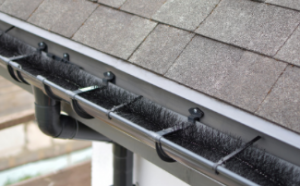As more people are choosing to have their gutters and downspouts professionally installed, they are also looking at DIY gutter guards to provide a protective layer. By using a DIY gutter guard, it is possible to get rid of the gutters completely if you want to, and it is also possible to have them replaced with a system that provides better drainage. However, there are some common misconceptions about what a gutter guard can do and the reasons why they are essential to your home’s drainage system.
 The main reason that many homeowners use this type of gutter guard is to reduce water seepage into the house. By adding a watertight covering over the gutter and downspout, it prevents rainwater from seeping into the foundation of the home, thus preventing it from causing structural damage. A lot of damage to the house can be caused by water being absorbed into the concrete of the structure. With a watertight covering on the gutter, water will fall off into the ground instead.
The main reason that many homeowners use this type of gutter guard is to reduce water seepage into the house. By adding a watertight covering over the gutter and downspout, it prevents rainwater from seeping into the foundation of the home, thus preventing it from causing structural damage. A lot of damage to the house can be caused by water being absorbed into the concrete of the structure. With a watertight covering on the gutter, water will fall off into the ground instead.
Another reason that gutter guards are so popular is because of the water that is allowed to flow freely through the drainage systems in the home. Water that is not able to run off into the ground can be released back into the household through the storm drains. Without a cover on the gutter, water can run right through the house. This can result in the accumulation of water in the walls, floors and even behind furniture. Water that cannot be drained back into the structure can eventually get stored in the basement of the home.
There are two types of gutter guards on the market. One is made of steel, and the other is made of metal pipes with some plastic covering. Depending on the materials used in the installation process, the type of guard that you install can either be made out of stainless steel or out of plastic. If the material used for the installation is a material that can corrode, the coating will need to be replaced.
If you choose to have the installation process done professionally, you can also choose to use a guard that is already installed. This is ideal if you want to save money on having to have one installed. However, if you’re looking to have a one-man job done, you might want to consider going with a DIY gutter guard. That comes in kits that include everything you need to have the job done, including all the fittings, pipe joints and seals.
You can learn more about what type of gutter guard would work best for your home by reading the installation instructions that come with the kit. The installation instructions will give you the option of using galvanized pipe, copper piping or stainless steel. As long as you’re working with good material, you should be able to install a DIY gutter guard that can effectively protect your home and keep water out. Once you’ve chosen the right one for you, there will be no reason to be concerned about rainwater running off your roof.